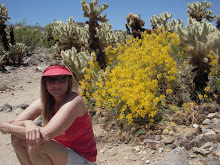






Before I started exploring and hiking in the desert--specifically in Joshua Tree National Park--I had no idea how many animals, insects, and birds lived there. From a distance, driving by in a car, wildlife is not easily seen. Desert animals are camouflaged and blend into the sandy terrain. Anyone remember what your mom used to tell you before you crossed the street? The trick to viewing desert birds or animals is to stop and look both ways. I'd add in, to listen.
Sometimes out hiking, you''ll startle a covey of quail or a jackrabbit hunkering behind a creosote bush. A hawk or golden eagle soaring overhead might track you. Occasionally when we're walking along a deserted road, we'll see vultures. William always jokes, "Don't sit down too long or they'll think we're dying and swoop on us." Once, tired after a long hike in the sun, we both spread out flat across a boulder to rest. A pair of turkey vultures circled for a closer look and then flew off.
Most of the time though, if you're walking along a road or trail, stop. You'll notice the sharp scent of mesquite and creosote. You'll hear the wind rustle. Maybe a bird call. Slowly, the critters, predators and prey, will start to creep, run, scurry past. If you sit long enough you'll see more movement than you might have imagined--a stinkbug waddling along, roadrunner speeding by, a coyote skulking for a meal.


Unfortunately, due to the encroachment of man, animal species that inhabit our Southwestern deserts have become endangered. Bighorn sheep, majestic creatures that can grow to be 250 pounds, used to number over one million. The Joshua Tree National Park population is now around 250. Bighorns are shy animals and usually prefer to gather on rocky cliffs. Sadly, a number of Bighorns are killed each year when they wander onto the highway in the Coachella Valley and other desert areas and are hit by cars. In many dozens of trips to the desert I've never seen a Bighorn, but I'm still hoping.
The desert tortoise is listed both on the California and Federal Endangered Species list. Adult tortoises weigh 10-15 pounds, and can live up to 100 years. When two male tortoises meet, they'll sometimes try to flip the other one over. An opponent left helpless on his back will often die of exposure or suffocation. Tortoises spend most of their time underground and stay within a few miles of where they're born. Tortoise populations are declining in the desert due to the road kill factor, habitat loss, and exposure to diseases from pet turtles released in the desert. I've never seen a desert tortoise in the wild but have found pieces of their shells.
Photos taken at Joshua Tree National Park: a sidewinder, a jackrabbit (whose outline can be seen at the far right of the image), snakeskins, a chuckwalla, a tarantula
Photo taken at Grand Canyon National Park, 2005: a raven

No comments:
Post a Comment